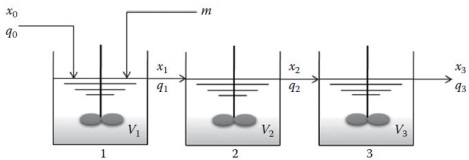Reference no: EM132474072
MPE0508 - Process Modeling and Simulation - National University of Science and Technology
Question 1:
Neural networks have been used as an alternative to the traditional mathematical models to simulate complex patterns. The simplicity of their implementation makes them appropriate for modeling various complicated processes. Neural computing is largely motivated by the possibility of creating an artificial computing network similar to the brain and nerve cells in human body. Recent advances in neuroscience and in computers have sparked a renewed interest in neural network models for problem-solving.
Briefly describe about the techniques, algorithm, architecture, methodology, application and significance of Artificial Neural Networks (ANN) practiced in emerging areas of scientific research. (Maximum 2500 words)
Question 2: The following set of differential equations describes the change in concentration of three species in a tank. The reactions A→B→C occur
within the tank. The constants k1, and k2 describe the reaction rate for A→B and B→C respectively.
The following ordinary differential equations (ode's) are obtained:
dCa/dt = -k1.Ca, dCb/dt = k1.Ca - k2.Cb dCc/dt = k2.Cb
Where k1=1 hr-1, k2= 2 hr-1 and at time t=0, Ca = ......P...... mol and Cb = Cc = 0 mol.
Solve the system of equations (using MATLAB) and plot the change in concentration of each species with respect to time. Select time interval for the integration as 0 ≤ t ≤ 5.
Question 3: Develop a ANN Model for the following input-output data related to leachate treatment process. Use MATLAB neural network toolbox to generate ANN function and predict the value of COD when pH = Q, H2O2/Fe2+ ratio = 16 and Fe2+ = 110. Plot regression graph, error histogram and all relevant parameters explaining relevant steps followed to build the model.
Run pH H2O2/Fe2+Ratio Fe2+ COD %
Degradation
1 3 8 110 43
2 5 8 110 30
3 3 16 110 30
4 5 16 110 16
5 3 8 190 N
6 5 8 190 42
7 3 16 190 32
8 5 16 190 29
9 2.3 12 150 45
10 5.7 12 150 22
11 4 5.1 150 53
12 4 18.9 150 34
13 4 12 80 U
14 4 12 220 34
15 4 12 150 35
16 4 12 150 36
17 4 12 150 37
18 4 12 150 34
Question 4: Table 1 shows measurements of reaction temperature versus time for a chemical reaction in a Plug Flow Reactor. Using MATLAB determine the 1st-order, 2nd-order, and 4th-order polynomials to represent this data.
Table 1 : Reaction Temperature versus Time
t (hr) 1 2 3 4 5 6 7 8
T (ºC) S 56.4 55.1 60.6 61.5 59.5 54.1 R
Also develop the regression equation for the 4th order polynomial model.
Question 5: Figure 1 shows a series of three well-mixed tanks. From mass balance equations, we have
dV1/dt = qo + m - q1 V1.dx1/dt = qo(x0 - x1) - mx1 V2.dx2/dt = q1(x1 - x2)
V3.dx3/dt = q2(x2 - x3)
where xi (i = 1, 2, 3) is the concentration (mol/liter) of the solution contained in the tank i. Under normal steady-state operation, m is maintained at 0 and qi (1, 2, 3) is kept constant.
At a certain time (t = 0), m is suddenly increased to 12 liter/min. Using MATLAB plot the concentrations in the three tanks from t = 0 to ...T...... The initial conditions are x0 = 0.15 mol/liter and q0 = 15 liter/min, and the initial volume of each tank is 20 liter.

Figure
Attachment:- Process Engineering.rar